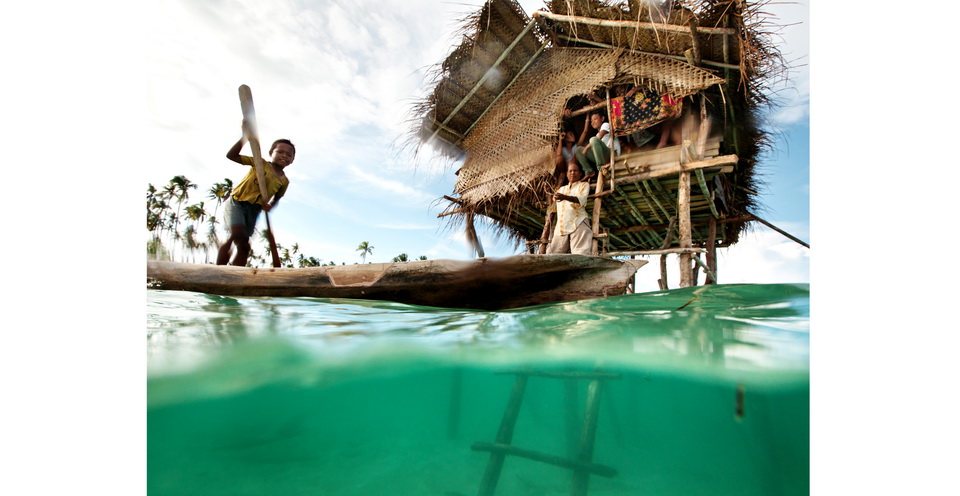
That’s a Bajau saying I learned three years ago while I was in Southeast Asia working on stories about the evolution of the human diet. I was visiting traditional, self-sufficient communities to see how food shapes daily life. Here I was arriving for lunch at this family’s home off the coast of Pulau Bodgaya (Bodgaya Island), in the Celebes Sea of northeast Sarawak, Malaysia. My host was named Marita. She was inside preparing food as I arrived.
The family is Bajau, one of several names used by roughly a million people living scattered along the coasts and archipelagos in Malaysia, Singapore, Indonesia and the Philippines. Bajau are often called “sea gypsies” for their frequently nomadic, subsistence ways, and to this day some do not hold a national citizenship.
The Bajau get most of their food directly from the ocean. They eat everything from many kinds of fish to sea urchins and octopi, all of which they catch mostly by spearfishing or gathering at low tide. Underwater, Bajau are famous for being able to hold a breath for several minutes.
It was not easy to get from shore to the house: I could swim or take a dugout canoe. I chose the canoe. With no language in common, I used my curiosity about food as a kind of universal way to communicate. On assignment or in my own daily life, I often bond with and become closer to people around food. It connects all of us.
We ate a simple meal of small fish fry with some ground cassava, which Marita prepared in a curved, wok-like pan over an open fire. The breeze cleared smoke through the bamboo lattice, and the six of us ate with our hands as the water lapped underneath the house.
—Matthieu Paley www.paleyphoto.com
The family is Bajau, one of several names used by roughly a million people living scattered along the coasts and archipelagos in Malaysia, Singapore, Indonesia and the Philippines. Bajau are often called “sea gypsies” for their frequently nomadic, subsistence ways, and to this day some do not hold a national citizenship.
The Bajau get most of their food directly from the ocean. They eat everything from many kinds of fish to sea urchins and octopi, all of which they catch mostly by spearfishing or gathering at low tide. Underwater, Bajau are famous for being able to hold a breath for several minutes.
It was not easy to get from shore to the house: I could swim or take a dugout canoe. I chose the canoe. With no language in common, I used my curiosity about food as a kind of universal way to communicate. On assignment or in my own daily life, I often bond with and become closer to people around food. It connects all of us.
We ate a simple meal of small fish fry with some ground cassava, which Marita prepared in a curved, wok-like pan over an open fire. The breeze cleared smoke through the bamboo lattice, and the six of us ate with our hands as the water lapped underneath the house.
—Matthieu Paley www.paleyphoto.com
You may also be interested in...

FirstLook: Ramadan’s Lanterns
Arts
In the March/April 1992 issue, writer and photographer John Feeney took AramcoWorld readers on a walk through the streets of Cairo during Ramadan.
FirstLook: Rain in Fayoum
Arts
I took this photo during a rainy day in November 2018 from the window of my family home in Fayoum, Egypt, located about 100 kilometers southwest of the capital. It hardly rains but a few times in the year in most parts of Egypt, and when it does, it is always something special, bringing Joy and happiness particularly for the local children.
Hijrah: A Journey That Changed the World
History
Arts
Avoiding main roads due to threats to his life, in 622 CE the Prophet Muhammad and his followers escaped north from Makkah to Madinah by riding through the rugged western Arabian Peninsula along path whose precise contours have been traced only recently. Known as the Hijrah, or migration, their eight-day journey became the beginning of the Islamic calendar, and this spring, the exhibition "Hijrah: In the Footsteps of the Prophet," at Ithra in Dhahran, Saudi Arabia, explored the journey itself and its memories-as-story to expand understandings of what the Hijrah has meant both for Muslims and the rest of a the world. "This is a story that addresses universal human themes," says co-curator Idries Trevathan.